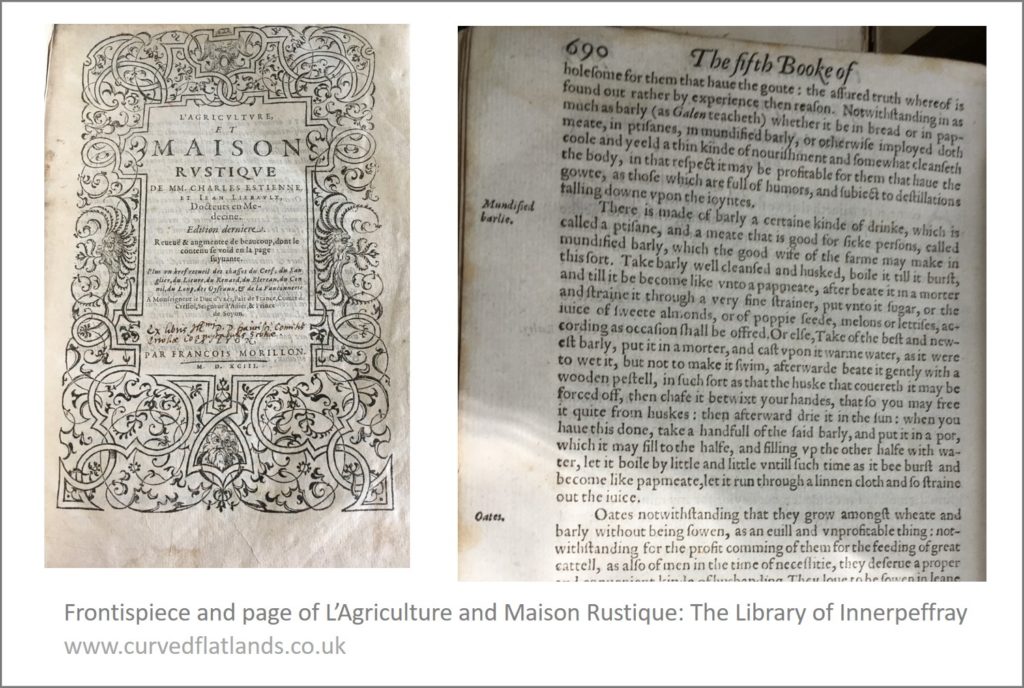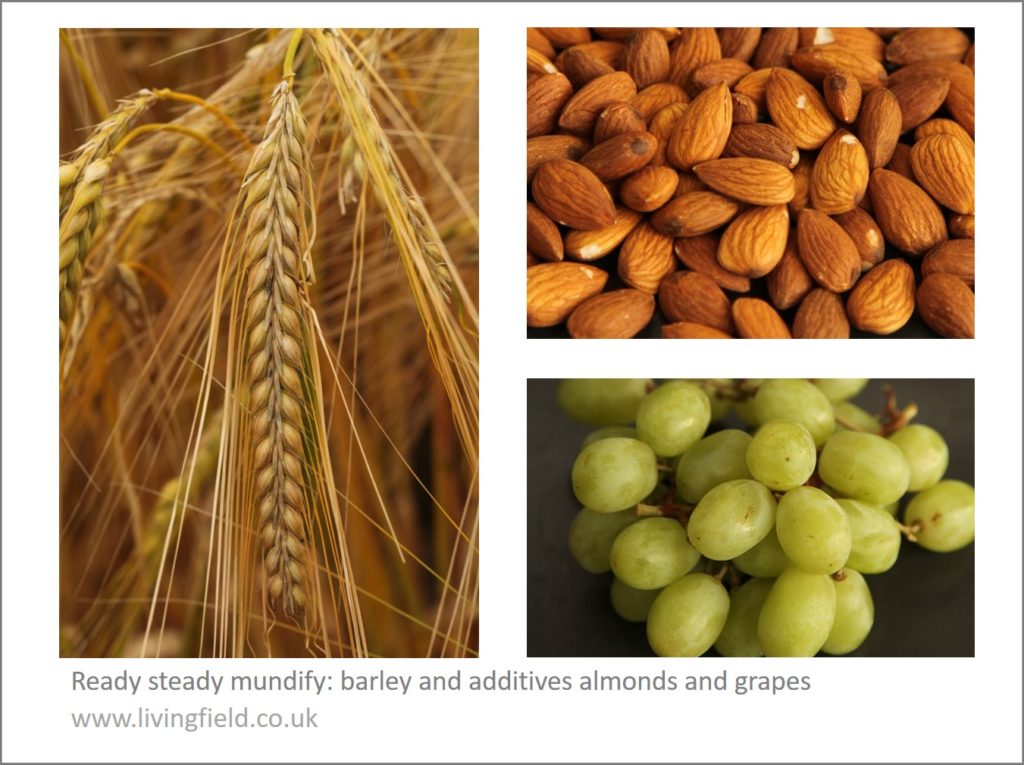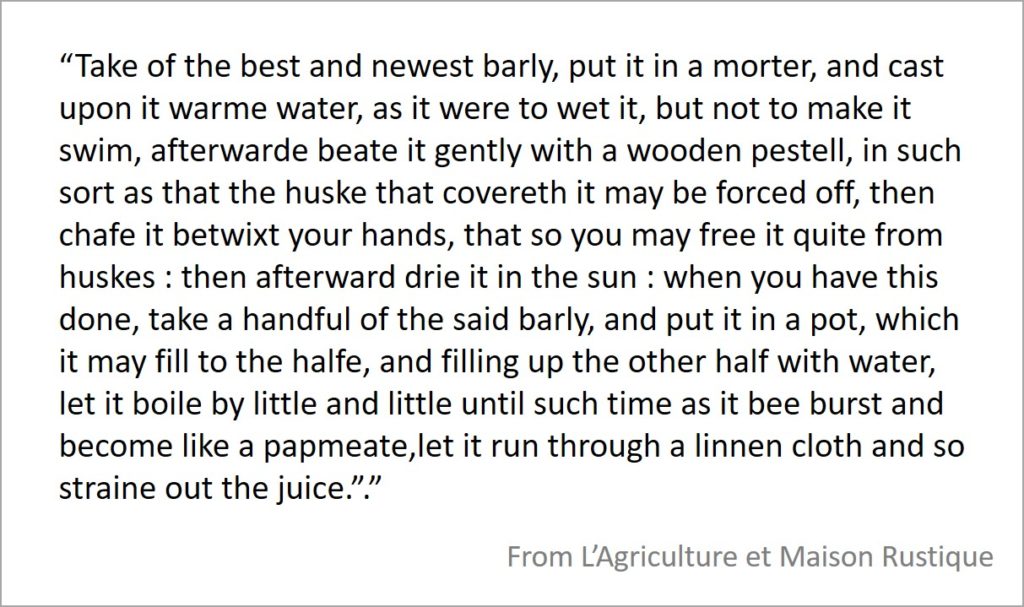“There is made of barly a certaine kinde of drinke …. and a meate that is good for sicke persons, called mundified barly.” (L’Agriculture et Maison Rustique 1593)
More than Aquavitae
The Library of Innerpeffray [1] holds a book, named L’Agriculture et Maison Rustique (1593), that tells of, among other things, how to grow crops and use their products. Touch, open, read ….. and you will get to the page on mundified barly or barlie [2].
As in many sources from the 1500s through to the early 1900s, barley was viewed as a nutritious food – a health-giving corn, much more than a raw material for alcohol. The book gives instructions on preparing the barley and in one case adding fruit juices or seeds.

Boil it till it burst
Preparation begins with rough barley grain and converts it one way or another to the consistency of papmeate. One method is to boil it, beat it, strain it …. and then the surprise …. add to it various juices or seeds as available. Here’s the original, the spelling kept where possible [3]:

The almonds referred to were presumably still juiceful, well before maturity (unlike those top right in the photo below). Other sources [3] offer slightly different methods of preparation and and suggest adding grape juice. Probably the juice of any fruit or sweet vegetable leaf would do.

To wet it but not to make it swim
The second process seems more involved. Wet it but not so much that it swims, beat it, force off the husks, chafe it between the fingers, dry it in the sun, put it back in water, boil it to bursting, strain it. So stressful … ! Here is the original.

Much more than Aquavitae – but was it bere
So there is in this account – and there is in many accounts from barley-country everywhere – procedures and recipes to convert this life sustaining grain to a food or healthy drink!
In temperate climatic regions unsuitable for wheat, the meal or flour from barley and oats was the main source of carbohydrate. (The equivalent crops in tropical Africa, for example, are the sorghums and millets).
In Scotland, bannocks [5], a form of flatbread made from barley with oatmeal and sometimes peasemeal, sustained the populace before it came to rely on traded cereal products in the later 1900s. After being cooked, bannocks remained in shape, flat and round, and so could be carried about.
The book says little about the varieties of barley that were mundified. They could well have been similar to ones grown here – the landrace known as bere [6] and more modern (for that time) cultivated forms.
Varieties resembling Scottish bere were known from parts of Europe. Lawson and Son (1836, 1852) refer to a form of bere grown in France and Germany and also a bere-like, naked six-row barley said to have come from mainland Europe [6]. If they mundified in Scotland, they could have added local wild fruits in season (not melon or grapes) or even kale-juice.
Maybe the Living Field will try to mundify? More to follow on barley as a food and health drink …..
Sources
[1] The Library at Innerpeffray. On a visit to The Library in September 2019 (GS writes), I was handed a book L’agriculture et maison rustique. The title page credits Charles Estienne and Jean Liebault. The book examined was dated 1593. Online sources list one edition printed in London 1600 with a variant of the title – The Countrie Farme – credited to Charles Stevens and John Liebault, and translated into English by Richard Surflet, Practitioner in Physicke. The book appeared in Latin, then in several languages and editions. Available online – see Dumbarton Oaks or search for the title.
[2] To Mundify: the Shorter Oxford Dictionary (third edition) indicates this is now rare or obsolete, descended from mundificare (latin) and meaning to cleanse, to purify, to free from noxious matter.
[3] The letter ‘u’ was written as ‘v’ and the letter ‘s’ has the appearance of a tall form of ‘f’. Barley appears as barlie and barly.
[4] Some examples. The title page of Dictionarire Oeconomique gives it written by M. Chomel in 1725: it advised the use of mundified barley or ‘barley water’ to counter various ailments (including Hectick-dever, for which the author also suggests small meals of frogs, snails, tortoise or good fish and ‘Asses Milk’). For another ailment, the preparation is a tisane of barley and marsh-mallow. In A garden of herbs by ES Rohde (1922), another 1600s source is given for a slightly different method of preparation, but the author calls it a Hordeat as well as mundified barley.
[5] The Living Field web site gives descriptions of bannocks made from assorted grain at Peasemeal, beremeal, oatmeal.
[6] Bere is a traditional barley landrace still grown in a few northern fields: further information at Bere line – rhymes with hairline. Lawson and Son’s descriptions of various beres can be found at Bere in Lawson’s Synopsis.
Contact/author: geoff.squire@hutton.ac.uk or geoff.squire@outlook.com
Online 16 October 2019, revised 6 November 2019.
